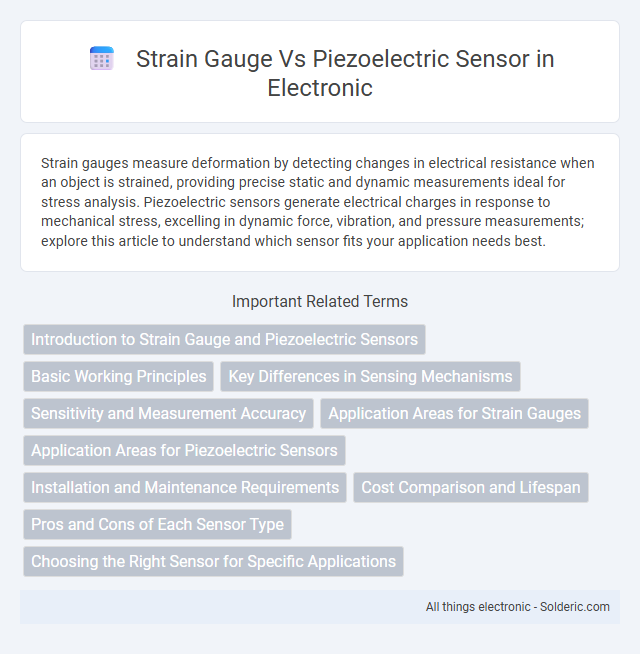Strain gauges measure deformation by detecting changes in electrical resistance when an object is strained, providing precise static and dynamic measurements ideal for stress analysis. Piezoelectric sensors generate electrical charges in response to mechanical stress, excelling in dynamic force, vibration, and pressure measurements; explore this article to understand which sensor fits your application needs best.
Comparison Table
| Feature | Strain Gauge | Piezoelectric Sensor |
|---|---|---|
| Working Principle | Resistance change due to strain | Voltage generation on mechanical stress |
| Measurement Type | Static and dynamic strain | Dynamic force, pressure, and vibration |
| Output Signal | Change in electrical resistance | Electrical charge/voltage |
| Sensitivity | High sensitivity to small strain | High frequency response, lower static sensitivity |
| Signal Conditioning | Requires Wheatstone bridge circuit | Requires charge amplifier or voltage amplifier |
| Operating Range | Low to moderate strain levels | Wide frequency range, unsuitable for static strain |
| Durability | Robust, long lifespan | Fragile, sensitive to environmental factors |
| Typical Applications | Structural health monitoring, stress analysis | Vibration monitoring, dynamic force measurement |
| Cost | Generally lower cost | Typically higher cost |
Introduction to Strain Gauge and Piezoelectric Sensors
Strain gauges measure static and dynamic strain by detecting changes in electrical resistance caused by material deformation, making them ideal for precise mechanical stress analysis. Piezoelectric sensors generate voltage output directly proportional to applied mechanical stress through crystalline material polarization, excelling in dynamic force, pressure, and vibration monitoring. Both technologies enable accurate structural health monitoring with strain gauges suited for low-frequency static measurements and piezoelectric sensors optimized for high-frequency dynamic applications.
Basic Working Principles
Strain gauges measure deformation by detecting changes in electrical resistance when an object is subjected to stress, converting mechanical strain into an electrical signal. Piezoelectric sensors generate an electrical charge directly proportional to applied mechanical stress through specific crystalline materials, enabling dynamic force and pressure measurements. Your choice depends on whether static strain measurements (strain gauge) or dynamic force detection (piezoelectric sensor) are required.
Key Differences in Sensing Mechanisms
Strain gauges measure deformation by detecting changes in electrical resistance as an object stretches or compresses, providing static and dynamic strain data. Piezoelectric sensors generate an electric charge in response to mechanical stress or vibrations, making them highly sensitive to dynamic changes but ineffective for static strain measurement. Understanding these key differences helps you select the optimal sensor based on whether your application requires monitoring of constant or transient forces.
Sensitivity and Measurement Accuracy
Strain gauges offer high measurement accuracy with stable output signals ideal for static or slowly changing loads, while piezoelectric sensors excel in sensitivity for dynamic measurements, detecting rapid changes in force or pressure. The inherent low noise and linearity of strain gauges make them suitable for precise, low-frequency applications, whereas piezoelectric sensors provide superior sensitivity in high-frequency environments but require additional circuitry for accurate low-frequency readings. Your choice should align with the required sensitivity and accuracy for the specific measurement context to ensure optimal sensor performance.
Application Areas for Strain Gauges
Strain gauges are extensively used in structural health monitoring, aerospace engineering, and mechanical testing to measure stress, strain, and deformation in materials under load. Industries such as civil engineering rely on strain gauges for monitoring bridges and buildings to ensure safety and integrity over time. Your precision measurement systems benefit from strain gauges' ability to provide accurate, stable data in static and low-frequency dynamic conditions.
Application Areas for Piezoelectric Sensors
Piezoelectric sensors excel in dynamic applications such as vibration monitoring, ultrasonic imaging, and industrial machinery diagnostics due to their high-frequency response and sensitivity to rapid changes. They are widely used in medical devices, automotive knock detection, and aerospace structural health monitoring, where precise measurement of pressure, acceleration, or force is crucial. Your choice of sensor depends on whether you require real-time, high-frequency data, making piezoelectric sensors ideal for transient force and dynamic pressure measurements.
Installation and Maintenance Requirements
Strain gauges require precise surface preparation and adhesive application for installation to ensure accurate strain measurement, with regular recalibration and inspection needed to maintain performance due to potential drift or damage over time. Piezoelectric sensors typically have simpler installation processes, often requiring less surface conditioning and allowing for fast attachment using bolts or adhesives, but they demand periodic checks for electrical connections and may need replacement rather than recalibration if damaged. Your choice between these sensors should consider the complexity and frequency of maintenance tasks aligned with your application's environmental conditions and longevity requirements.
Cost Comparison and Lifespan
Strain gauges generally offer a lower initial cost compared to piezoelectric sensors, making them more suitable for budget-sensitive applications. However, piezoelectric sensors often provide a longer lifespan and higher durability under dynamic loading conditions due to their solid-state construction. The maintenance expenses for strain gauges can be higher because they are more sensitive to environmental factors like temperature and humidity, potentially reducing their effective lifespan.
Pros and Cons of Each Sensor Type
Strain gauges offer high accuracy and sensitivity for measuring static and low-frequency strain but require careful temperature compensation and can be susceptible to drift over time. Piezoelectric sensors excel in dynamic measurements with fast response times and wide frequency ranges but cannot measure static strain and may require charge amplifiers for signal conditioning. Both sensor types serve distinct applications, with strain gauges preferred for steady-state monitoring and piezoelectric sensors ideal for detecting transient or vibration events.
Choosing the Right Sensor for Specific Applications
Strain gauges excel in measuring static or low-frequency strain with high accuracy and stability, ideal for applications such as structural health monitoring and material testing. Piezoelectric sensors are best suited for dynamic measurements involving high-frequency forces, vibrations, or pressure changes, commonly used in impact testing and machinery diagnostics. Selecting the right sensor depends on factors like measurement type, frequency range, sensitivity requirements, and environmental conditions.
strain gauge vs piezoelectric sensor Infographic

 solderic.com
solderic.com